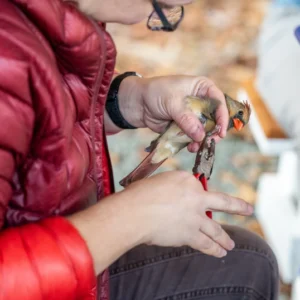Every Bird Rescued and Rehabilitated is a Victory for Its Species
Cliff Swallows are social birds that forage and migrate in flocks, consisting of hundreds of cooperative individuals. They also construct their nests side-by-side in colonies that can have thousands of active nests at a time. Observing a colony of nesting Cliff Swallows, from a respectful distance, as hundreds of parents fly back and forth to feed their hungry young is truly a fascinating experience. You might be surprised to know that you could be driving past one of these colonies on your way to work without even realizing it!
Cliff Swallows are skilled masons who build gourd-shaped nests entirely out of mud. Each mouthful of mud is intentionally placed into position and dries into a strong miniature brick. After approximately 1,000 mouthfuls of mud, the nest is complete and ready for eggs. As the nest structure is vulnerable to heavy direct rain, Cliff Swallows must find a protected area to build their nests. Historically, their population was confined to the western mountains of North America, where horizontal rock ledges are abundant and ideal nesting sites. However, in the last 150 years, their range has expanded to eastern North America as human-made structures such as bridges, culverts, and buildings provide excellent alternative nesting sites.1
Using human-made structures as nest sites has been beneficial for Cliff Swallows to expand their geographic range, but living near human populations poses additional risks. The Cliff Swallow population, similar to most aerial insectivore species, has suffered significant population declines since 1970.2 Our small actions to reduce risks, protect habitats, and provide injured birds with a second chance at life will all contribute to the long-term success of this species!
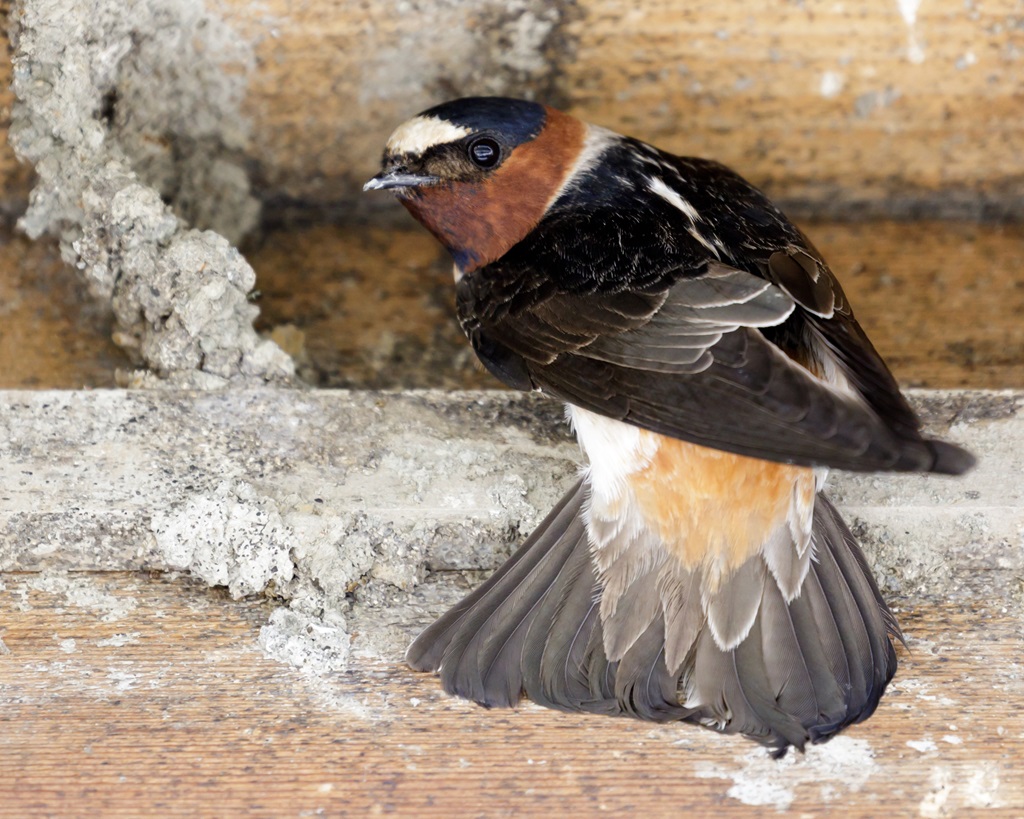
Male Cliff Swallow near mud nest. Source: Shutterstock
Each year the Ottawa Valley Wild Bird Care Centre (OVWBCC) provides rehabilitation care to over 3,000 injured, ill, and orphaned wild birds with the ultimate goal of releasing them back into their natural habitat. The majority of adult birds brought to the OVWBCC require life-saving care because of a vehicle collision, window collision, or cat/animal encounter. During the summer months, young birds most often require care because of a cat/animal encounter, nest fall, or nest destruction. It is during the breeding season, when young Cliff Swallows first leave the nest, that the OVWBCC receives the most Cliff Swallows, all thanks to observant, caring individuals like yourself who rescue them!
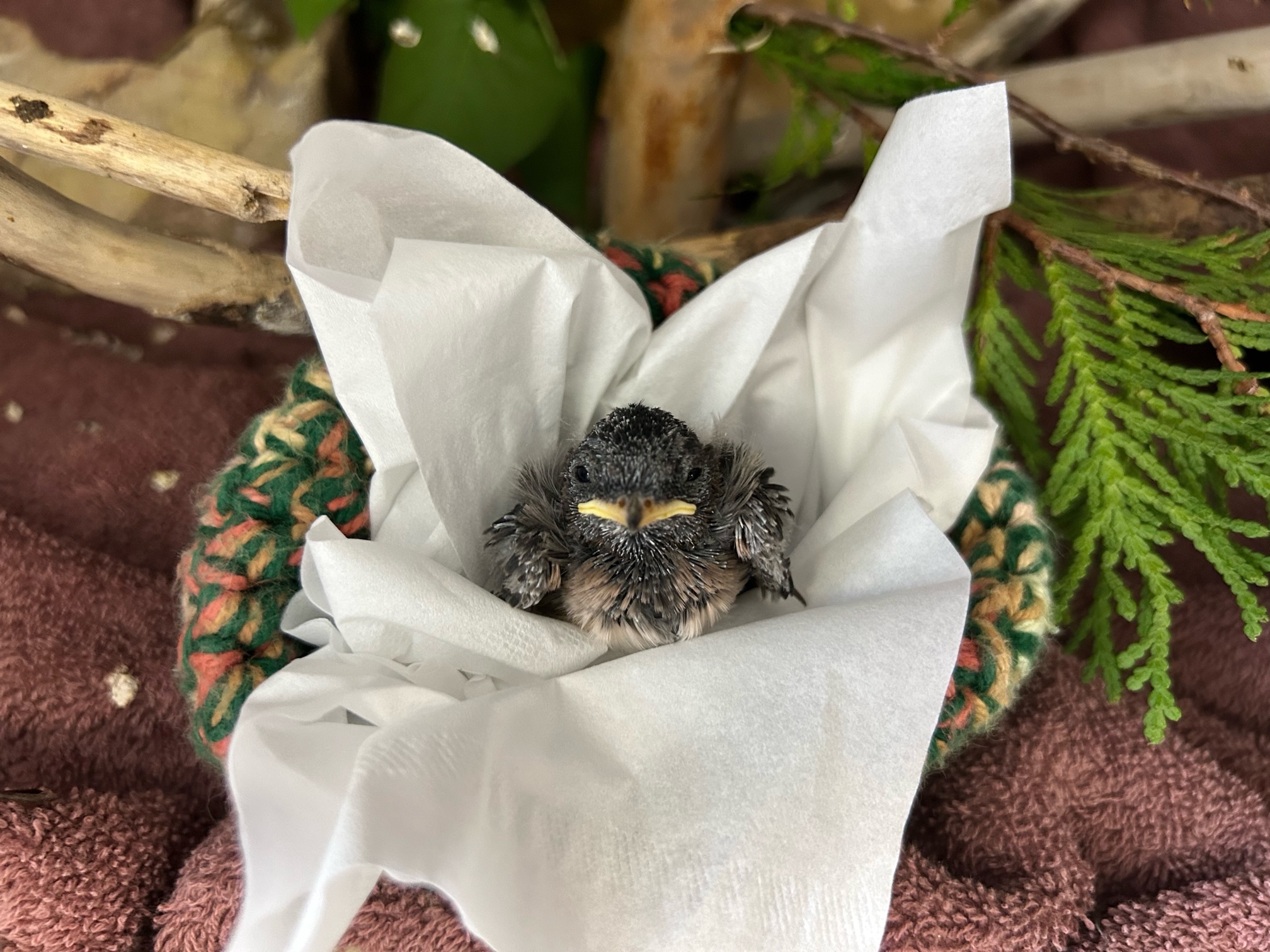
Cliff Swallow nestling at Ottawa Valley Wild Bird Care Centre. Source: Patty McLaughlin
Cliff Swallows are one of the most memorable baby birds cared for each year at the OVWBCC. They are noticeably quieter than most songbirds, they have a cooperative personality, and their natural grumpy face makes them extra adorable. This grumpy face look is caused by an enlarged fleshy area that borders their mouth, called the gape flange. It makes their mouth bigger and brighter when they beg for food, helping to ensure that their parents or our avian care team do not miss their target during feeding time.
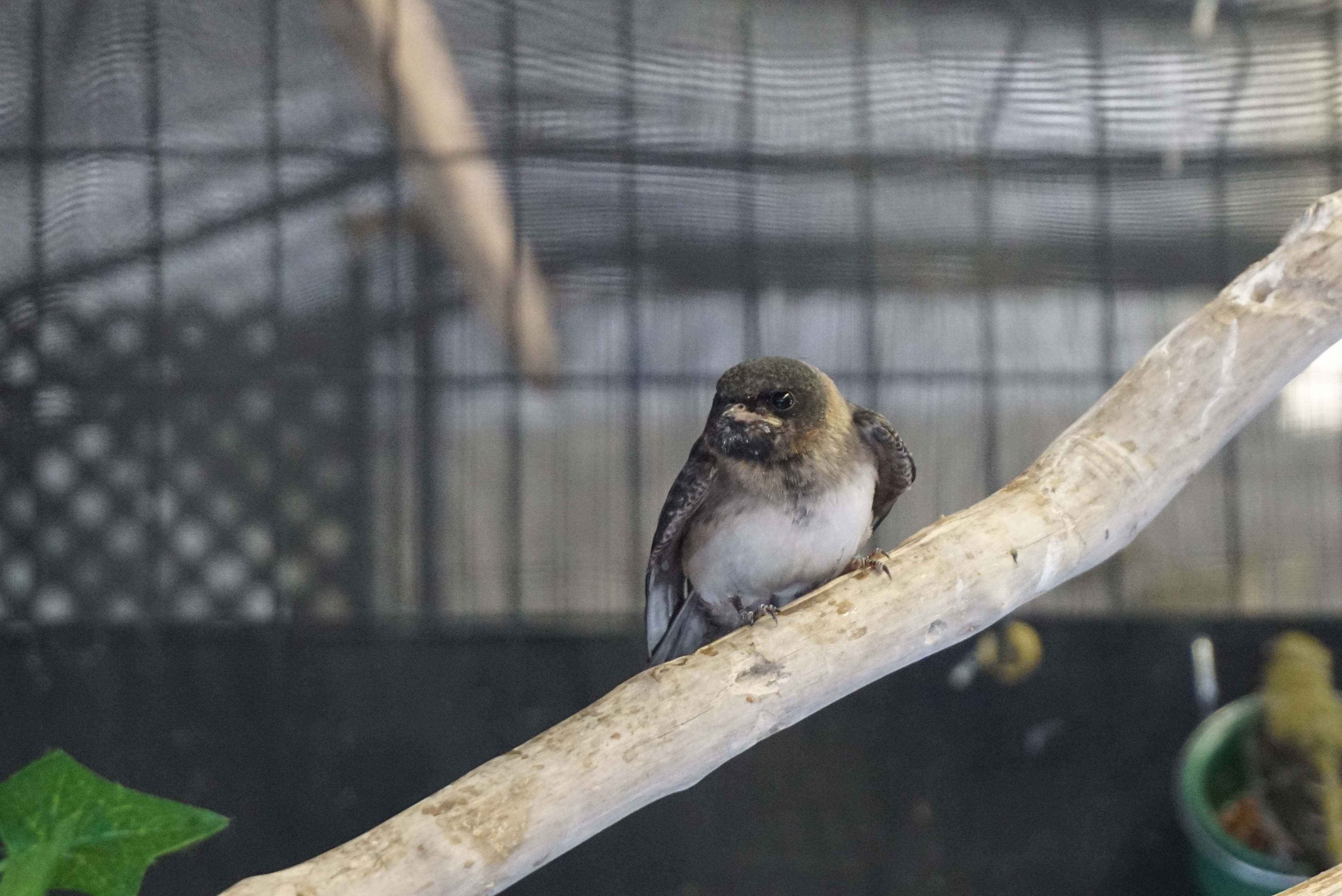
Cliff Swallow in Flight Cage at Ottawa Valley Wild Bird Care Centre. Source: Patty McLaughlin
True to their name, these birds know how to swallow a meal and often! Young swallows in care at the OVWBCC require small but frequent feedings of insects and specialized diets every 20 minutes throughout the day. A single young swallow spending a month in care will consume thousands of crickets, worms, and other insects before they are ready for release. Can you imagine the extent of natural insect control a flock of Cliff Swallows provides to their surrounding habitat?
When it is time for a rehabilitated Cliff Swallow to return to the wild they are brought back to the area in which the rescuer first found them. The tiny white feathers on their forehead and throat that helped our avian care team identify them from a similar Barn Swallow, is also what might help their family recognize them as well! When young Cliff Swallows leave the nest they congregate in large groups called ‘creches’. When the parents return with food they use the difference in auditory calls and plumage patterns to help identify their own young. From a safe perch in the creche, the young get their first glimpse of the flock’s teamwork which will be essential to their survival. “No hungry bird is left behind” could be the swallow’s life motto.
Cliff Swallows use specific calls to alert the flock of an insect swarm. Once located there will always be a few individuals in the flock who will take turns and stay with the insect swarm, tracking its movement until the food source is depleted. Cliff Swallows are amazing birds that can teach us a lot about ingenuity and teamwork and that is exactly what it takes to protect a species!
YOU are the very important first step for an injured, ill, or orphaned bird to receive a second chance at life at a licensed rehabilitation centre.
If you have found an injured bird
Please always consider your safety first when attempting to rescue a bird, especially near roads and water. If you have found a young bird during nesting season, consider the possibility that they may be an uninjured fledgling learning how to fly, or perhaps the bird can be reunited with their parents. Please reach out to a registered wildlife rehabilitation centre if you are unsure.
Ottawa Valley Wild Bird Care Centre
Nature Canada Page with list per province
To rescue a wild bird
Using a towel, approach the bird and cover their body completely with the towel. Place the bird and towel in a secure box, pet carrier, or unwaxed paper bag for transport. Make sure the towel is not covering the bird’s head, you can place the towel under the bird for comfort and support. Keep the bird in a dark, quiet container away from pets and do not provide any food or water. Contact the OVWBCC or a local licensed wildlife rehabilitator if you require temporary care advice. Wash your hands thoroughly after being in contact with a wild bird or their rescue container.
The OVWBCC and other licensed rehabilitation centres across Canada provide a second chance at life for those who have become injured or ill. However, our small actions to help protect wild birds and their habitats can also add up to make a big difference!
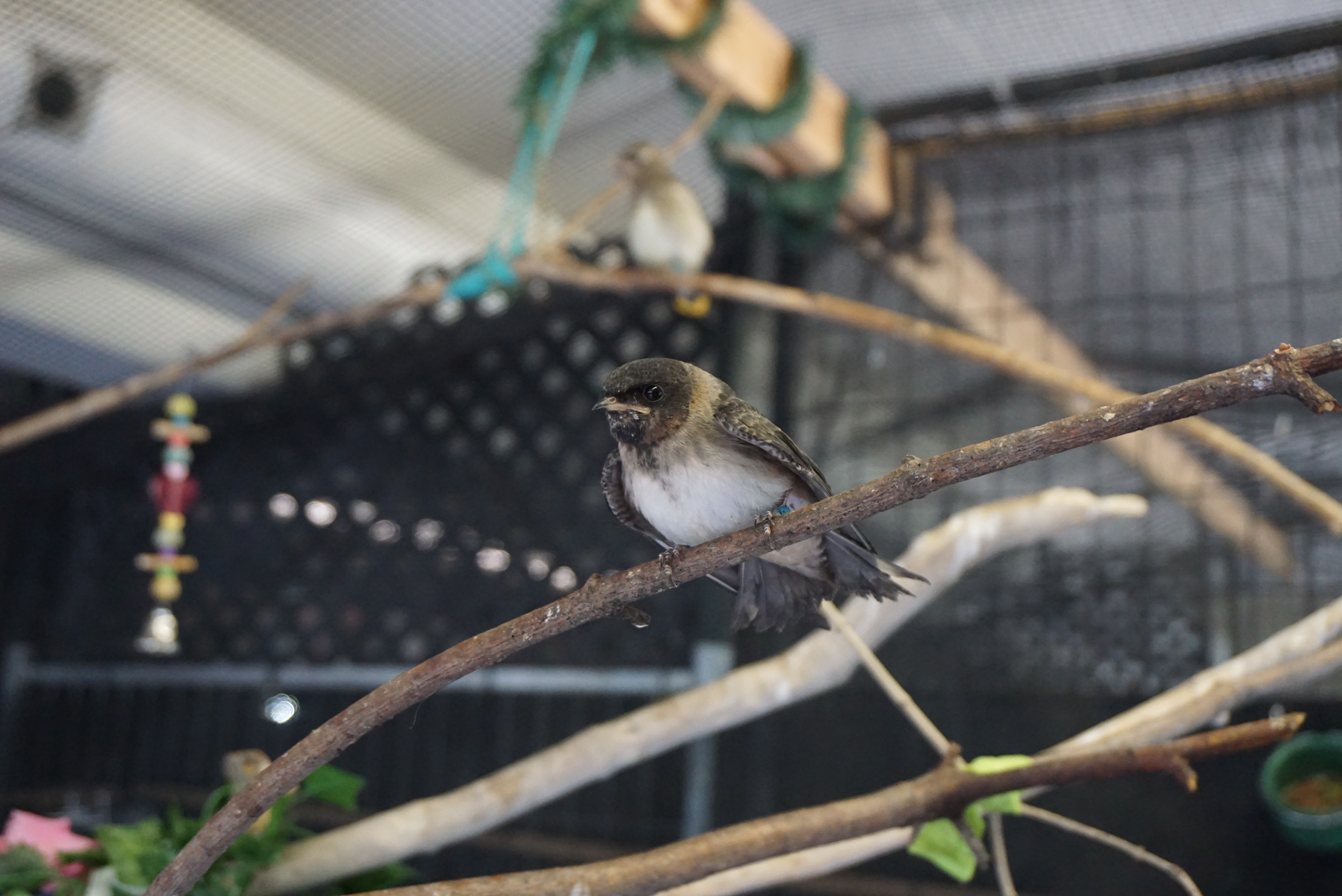
Cliff Swallow in Flight Cage at Ottawa Valley Wild Bird Care Centre. Source: Patty McLaughlin
Here are some ways to help protect Cliff Swallows and other swallow species
- Preserving their food source by not using pesticides, not cutting back gardens and overgrown meadows, and planting more native plant species
- Be mindful not to disturb known or potential nest sites, especially those that have shared usage with humans
- Being a responsible pet owner, knowing where your pet is at all times, especially during the nesting season
- Provide an open wet patch in your garden for mud collection and help maintain natural shorelines at recreational properties.
- Turn out your lights at night during migration season and apply high-density, high-contrast marks on the outside of your window to prevent collisions
- Celebrate them this World Migratory Bird Day and share the message “Protect Bugs to Protect Birds”
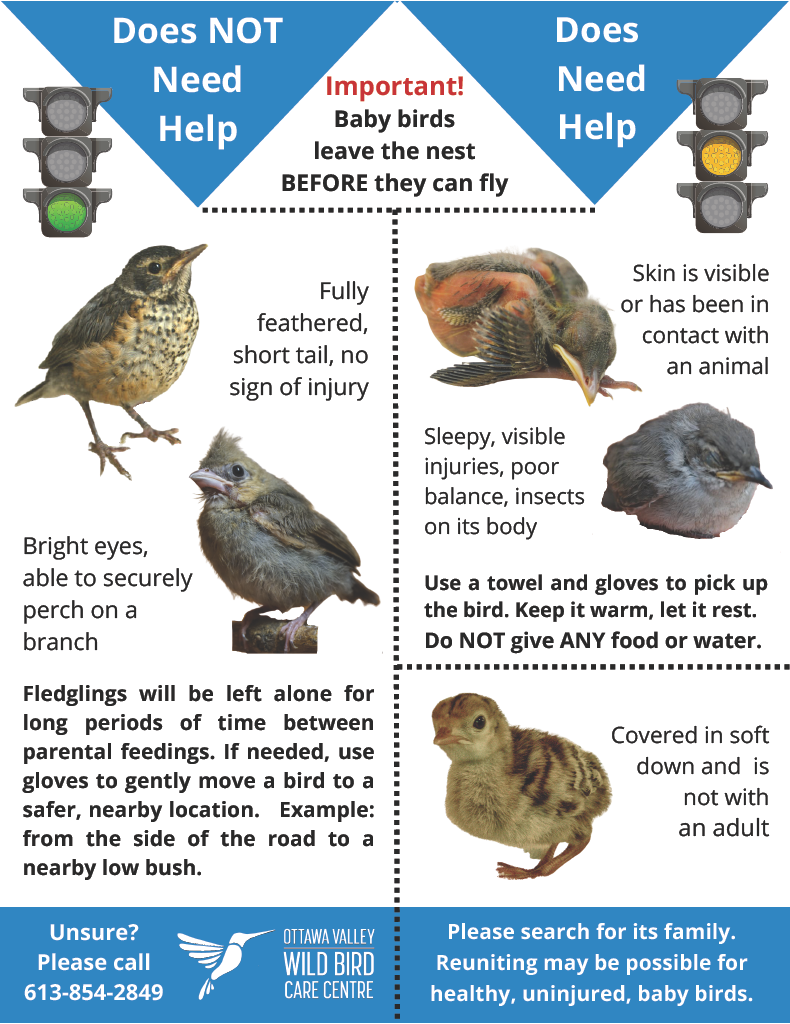
1 Nebel, S., A. Mills, J. D. McCracken, and P. D. Taylor. 2010. Declines of aerial insectivores in North America follow a geographic gradient. Avian Conservation and Ecology – Écologie et conservation des oiseaux 5(2): 1. [online] URL: http://www.ace-eco.org/vol5/iss2/art1/
http://dx.doi.org/10.5751/ACE-00391-050201
1 Environment and Climate Change Canada. 2019. The Status of Birds in Canada Website, Data-version 2019. Environment and Climate Change Canada, Gatineau, Quebec, K1A 0H3


